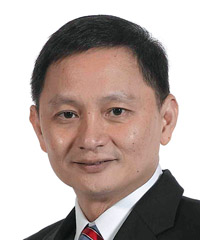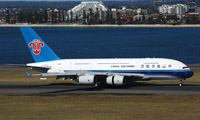Special Report: Singapore Aerospace
SIA shifts gear
Singapore’s role as the region’s leading aerospace hub is pivoted on the success of its flag ship carrier, Singapore Airlines (SIA). Under the stewardship of youthful CEO, Goh Choon Phong, SIA has marked out a new growth strategy to sustain the future bottom line of one of the world’s most profitable and respected airlines.
February 1st 2014
Singapore Airlines is one of the Asia-Pacific’s most successful carriers, admired by competitors for its high quality service and consistent operational performance. Read More » But like all of the region’s leading full-service carriers it is doing business in an aviation landscape that is changing at a furious pace - as Gulf, Mainland Chinese and ever more LCCs demand their share of the region’s expanding market.
 |
| 'We must venture outside our comfort zone … It cannot be business as usual and I cannot stress this point enough' |
| Goh Choon Phong CEO Singapore Airlines writing in the airline’s in house magazine |
Early last year, in the company’s in-house magazine, Singapore Airlines (SIA) CEO, Goh Choon Phong, left staff in no doubt the carrier faced a tough operating environment.
It would be an ongoing battle to hold market share and fend of attacks on its hub from cash-rich rivals and low-cost carriers nibbling away at its business, he said.
“We must venture outside our comfort zone, find new ways to conduct our sales and marketing, reduce expenditure and improve both productivity and operational efficiency,” he told employees.
“It cannot be business as usual, and I cannot stress this point enough.”
Just how challenging soon became clear. SIA’s full-year net profit for the twelve months ending March 31 slumped 69% year-on-year, to $267 million, mostly as a result of high fuel costs – about 40% of its expenses – and economic conditions in Europe and the U.S.
Corporate travel budgets, on which SIA heavily relies, have been trimmed. Indeed, the carrier actually suffered a $30.4 million loss in the fourth quarter; only the third quarterly loss in the airline’s history.
In effect, SIA was facing a competitive onslaught on several fronts: Gulf carriers pouring additional capacity into the region, the rapid growth of budget operations, which now represent a quarter of all traffic at Singapore Changi airport, the new Qantas-Emirates alliance and the strategy of China Southern Airlines to draw Kangaroo route traffic to Europe via its Guangzhou hub.
As well, freight, another key element of the business, has only recently shown signs of improving life.
At the same time, neighbouring carriers have been ramping up their challenges to SIA’s market. Malaysia Airlines and Thai Airways International (THAI) are operating A380 services to Europe and smaller carriers such as Garuda Indonesia and Philippine Airlines are modernizing and expanding their fleets. All these factors are challenging SIA’s traditional marking edge of supreme, consistent service aboard an aircraft fleet of cutting edge modernity.
As the challenges have persisted, Goh barely flinched – at least to the outside world. Since he took charge on January 1, 2011 he has directed the carrier along pathways that have been significant in their changes in strategy.
Long seen as one of the region’s more traditional operators, SIA made one step out of its conventional box before Goh’s arrival, when it invested low-cost carrier, Singapore-based Tigerair (formerly Tiger Airways). Goh went one big step further and launched new long-haul LCC, Scoot, in mid-2012. Last month, Scoot passed the two million passenger mark and now operates to 13 destinations. Recently, Scoot established a joint venture Thai LCC, NokScoot.
In the meantime, Goh negotiated the setting up of a long-held SIA ambition - to make its mark in the huge future market of the Indian subcontinent. SIA and its Indian partner, conglomerate
Tata, appear close to surmounting all the regulatory hurdles to establishing a full service carrier in India.
India’s Foreign Investment Promotion Board has approved the joint venture, which gives SIA 49% in the yet-to-be named airline, with Tata holding the remaining 51%. Planned to fly from mid-year, the airline will be based in Delhi and be developed with initial funding of US$100 million.
Many observers believe the joint venture is a high risk strategy, but Goh is undaunted. “By no means do we think this is going to be a walk in the park,” he told analysts at a recent briefing.
 |
| China Southern Airlines: intent on taking its share of European bound Australasian travelers via its hub in Guangzhou |
“The venture being set up in India will have its challenges. We are all familiar with some of the challenges in India. It’s a very competitive market domestically, and, for a start-up, the current rule says an airline has to operate for five years and have a fleet of 20 aircraft before you’re allowed to go abroad.
“It is going to be a highly challenging venture to actually make it work. We don’t take it lightly. But, of course, if we did not have the confidence to make it work, we wouldn’t have been there.
“As with any venture, there will be risks. But we believe that is acceptable, given the potential and the benefits we see this venture eventually bringing in.”
In a more recent development, SIA LCC subsidiary, Scoot, has announced a joint venture long-haul LCC in partnership with Thailand’s Nok Air, which in turn, is part owned by THAI. In the same month, another SIA-controlled LCC subsidiary, Tigerair, announced a LCC joint venture, Tigerair Taiwan, with Taiwan’s China Airlines.
Goh has clearly decided a multi-brand strategy, with a strong regional emphasis is a key factor in fighting off competition. In late 2012, he sold the carrier’s 49% stake in Virgin Atlantic to America’s Delta Airlines, an investment many analysts said had not provided satisfactory returns.
Instead, SIA turned to Australia, a market in which it has a big interest, and bought a 10% holding in Virgin Australia, an investment that has increased to 19.9%. The tie-up has given SIA much greater access to the Australian market and has allowed it to compete more effectively with Qantas.
The latest statistics from Australia’s transport department confirm this growth. SIA has a 9.1% share of Australia’s international passenger traffic, after Qantas (17.2%) and just ahead of Emirates Airline (8.8%).
If there is one area in SIA’s strategy which needs strengthening, according to analysts, it is SIA’s Mainland Chinese market presence. Some analysts have gone as far as suggesting SIA should pull out of the Star Alliance, in which it has been a long-time member and join Skyteam. Skyteam has both Guangzhou-based China Southern Airlines and Shanghai’s China Eastern Airlines as members, which would provide SIA with more opportunities to increase Chinese ties. However, such a decision seems unlikely, not least because of the high cost of resigning from one alliance and joining another.
Despite the tough market conditions, Goh has ensured SIA is not being left behind at an operations or customer service level. Last year, SIA ordered aircraft valued at US$17 billion: 30 A350-900s (with 20 options that can be converted to larger A350-1000s) and 30 B787-10Xs.
The orders were amongst the biggest in SIA’s history and are “helping to ensure that we retain our industry leading position. They demonstrate our commitment to the Singapore hub and our confidence in future premium full-service travel”, said Goh. The airline ordered five more A380s and 20 A350s in 2012, as well as 54 B737s for its subsidiary, SilkAir.
In the same year, SIA hired Bayerische Motoren Werke, or BMW, and James Park Associates to undertake its biggest premium cabin upgrade in more than five years. The carrier is spending $400 million on a state-of-the-art in-flight entertainment system and another $20m upgrading its global network of lounges. Gulf operators such as Emirates, Etihad and Qatar, fierce rivals of SIA for premium passengers, have spent tens of millions of dollars to provide their corporate customers with luxury offerings, particularly airport lounges.
There has been a marked improvement in the airline’s finances since last year. In the first quarter of the current fiscal year, ended June 30, net income rose to $96 million, from $62 million, in the same period a year earlier. In the second quarter, to September 30, net profit rose 78% to $128 million. Nevertheless, the carrier’s operating margin was once again low, particularly by SIA standards, as it continues to see a drop in yields. Mainline passenger yields slipped from US$9.1 cents to US$8.8 cents. Goh told analysts at a briefing: “We expect to have continued pressure on our yields as competition heats up and the economy is somewhat sluggish.”
SIA is heading for another profitable year, but its margins are not nearly as high as they used to be. The competitive landscape has changed dramatically, which has provided some of the biggest challenges in the group’s history. SIA has adjusted to the new fiscal challenges, but it will be a few years before the strategic shifts are judged to have been sufficient to produce a new era of higher profitability.